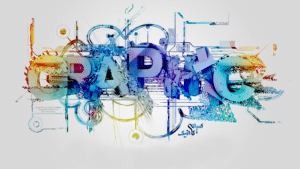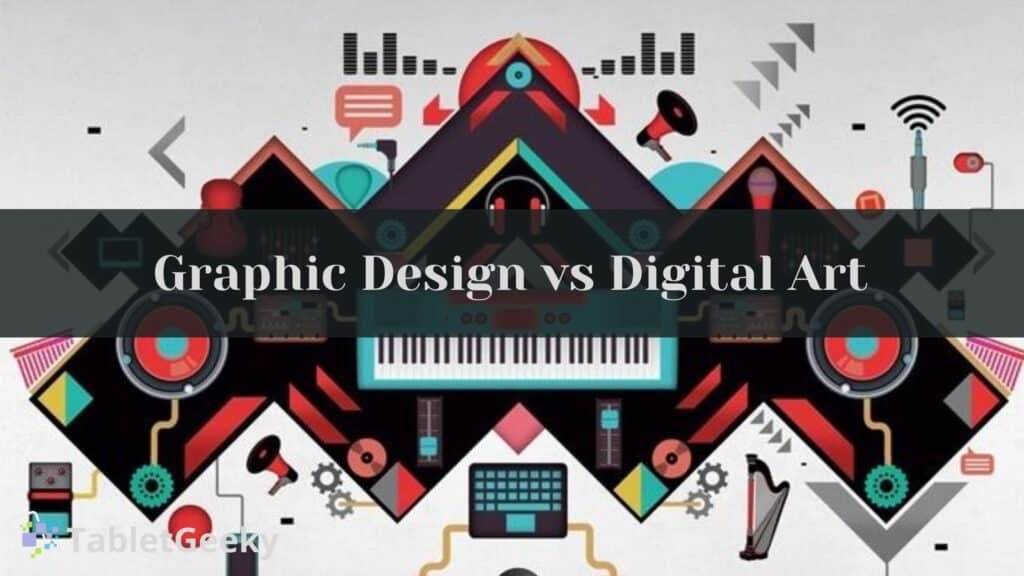Graphic design and digital art differ in purpose, process, and outcome. Both rely on digital tools, yet they exist in distinct creative territories. Graphic design emphasizes communication, clarity, and function. Digital art emphasizes imagination, beauty, and emotional connection. Understanding this difference is essential for anyone pursuing visual creativity or digital careers.
Both disciplines shape modern visual culture. They define how people consume information, experience media, and connect with ideas through visuals. Recognizing their boundaries allows creators to choose the right direction for education, career growth, and artistic fulfilment.

Table of Contents
Definition of Art and Design
Art expresses imagination, emotion, and individuality. It reflects personal interpretation and evokes aesthetic pleasure or introspection in viewers. Artists create from within—without external restrictions—seeking to communicate feeling rather than solve a functional need.
Design solves communication problems through structure and logic. It translates ideas into visuals that guide users or audiences toward an intended message. A design succeeds when it conveys meaning efficiently, even if it isn’t conventionally beautiful. Art invites reflection; design demands comprehension.
Difference Between Graphic Design and Digital Art
Digital art focuses on creativity; graphic design focuses on communication. Both exist in the digital space but serve separate purposes. Digital artists create expressive visuals that highlight emotion and storytelling. Graphic designers use visual systems to solve communication challenges for businesses or organizations.
Digital artists produce work for artistic consumption—illustrations, concept art, or digital paintings. Graphic designers build usable communication—logos, advertisements, or user interfaces.
Medium overlap exists, yet intent defines separation. When an artwork serves emotion, it is art; when it serves function, it is design.
3 Key Differences:
- Purpose: Art expresses; design communicates.
- Outcome: Art values aesthetics; design values clarity and usability.
- Process: Artists create intuitively; designers follow strategy and structure.
Understanding this distinction helps creators develop the right mindset for their craft.
Graphic Designer vs Digital Artist
A graphic designer communicates visually. A digital artist creates visually.
Designers bridge brands and audiences by conveying ideas visually. They interpret goals and translate them into understandable compositions. Digital artists, however, translate imagination into form—free from commercial restrictions.

Designers address communication problems—creating advertisements, packaging, and interfaces that strengthen brand identity. Digital artists express vision—producing visuals for films, games, and galleries that evoke feeling and depth.
Examples of Graphic Designers:
- Web Designer – crafts user-focused online layouts.
- Packaging Designer – creates brand-consistent product visuals.
- Motion Graphic Designer – animates graphics for digital media.
Examples of Digital Artists:
- Concept Artist – visualizes characters or environments.
- Matte Painter – builds cinematic backgrounds.
- 3D Artist – sculpts objects and scenes digitally.
Intent defines identity: A digital artist’s work in a poster remains digital art; the designer’s arrangement of it defines graphic design.
What Is a Graphic Designer?
A graphic designer creates structured visual concepts that communicate information with intent.
They combine typography, imagery, and color to form meaningful compositions that guide perception and understanding.
Graphic designers collaborate closely with clients, writers, marketers, and developers. They research audience behavior and design accordingly. Their work impacts brand visibility, message retention, and user engagement across both print and digital platforms.
Educational Background:
Most designers hold a Bachelor’s degree in Graphic or Communication Design, yet many successful professionals build expertise through self-learning, online courses, and project experience. A strong portfolio consistently outweighs formal education.
Principles of Graphic Design
Graphic design follows core principles that establish structure and harmony.
The four fundamentals—contrast, repetition, proximity, and alignment—form the foundation of every effective composition.
- Contrast distinguishes elements, creating visual hierarchy.
- Repetition builds consistency across materials and layouts.
- Proximity groups related elements to improve comprehension.
- Alignment maintains visual order and balance.
Advanced principles such as balance, rhythm, color, line, shape, texture, and typography further refine composition. These guide the viewer’s eye, ensure emotional impact, and connect design with its purpose. Every professional designer internalizes these principles through analysis and practice.
Who Is a Digital Artist?
A digital artist produces visual content using technology as the primary medium.
Their goal is to translate imagination into visuals that inform, entertain, or inspire. Digital artists use Artist’s Tablet digital brushes, modeling tools, and animation software to construct visuals across industries—from entertainment to education.
Digital artistry blends creativity with technology. It demands sensitivity to form, light, and storytelling, along with command of digital tools. Collaboration is common; digital artists often work with directors, designers, and production teams to deliver cohesive visual outcomes.
Purpose of Digital Art
Digital art enhances storytelling through visual emotion and realism.
Digital artists conceptualize scenes, characters, and atmospheres that support narratives across film, gaming, and advertising.
Common Digital Art Tasks:
- Design visual assets that align with creative briefs.
- Illustrate concept scenes and characters for animation or film.
- Collaborate with creative teams to ensure consistent visual tone.
- Refine aesthetics through lighting, texturing, and motion.
Digital art’s purpose lies in connection—it transforms imagination into a tangible digital form that resonates emotionally with viewers.
How to Become a Digital Artist
To become a digital artist, master both artistic fundamentals and digital tools.
- Learn drawing and painting. Develop spatial awareness and perspective.
- Study color theory and lighting. Understand how hues and shadows create realism.
- Practice using digital tools. Learn Photoshop, Procreate, Blender, or ZBrush.
- Build a portfolio. Display a range of creative styles and techniques.
- Seek feedback and opportunities. Collaborate, freelance, and refine your style through consistent output.
Digital art careers remain in high demand, especially in entertainment, advertising, and gaming industries, where visual storytelling drives engagement.

Career Options in Digital Art
Digital art offers a wide range of creative career paths.
Professionals work independently, in agencies, or within production studios.
- Concept Artist: Develops ideas for visual media.
- Illustrator: Creates detailed visuals for print or digital formats.
- Matte Painter: Designs cinematic environments.
- Storyboard Artist: Pre-visualizes film or animation sequences.
- 3D Artist: Builds digital models for games and movies.
- Animator: Brings movement and personality to visuals.
- Digital Painter: Produces high-fidelity digital artwork for marketing or fine art.
Each position merges artistic sensitivity with technical execution, shaping the visual identity of modern media. After reading this you may also ask what is graphic designer or how to be in that career?
Elements of Digital Art
Digital art relies on seven essential elements that enhance realism and aesthetic integrity.
- Color, Tint, and Tone: Define emotion, contrast, and depth.
- Blending: Creates smooth transitions between hues.
- Light and Shadow: Establish three-dimensional realism and spatial depth.
- Reflection: Simulates surface and light interaction for lifelike appeal.
- Shape and Proportion: Maintain anatomical and spatial accuracy.
- Perspective and Composition: Guide viewer attention within digital space.
- Brushes and Texture: Add detail, surface complexity, and tactile effect.
Mastering these elements enables digital artists to replicate realism, amplify emotion, and craft immersive visual experiences. Also, I tried many other tools for digital artists which blends so well for me.
Skills Required by a Graphic Designer and a Digital Artist
Graphic designers and digital artists share creative, analytical, and technical competencies.
They combine artistry with precision to produce visuals that serve distinct objectives.
Core Skills for Digital Artists:
- Sketching and Drawing
- Character and Environment Design
- Composition and Balance
- Color Theory Application
- Light and Shadow Control
- Animation and Rendering
- Typography and Visual Harmony
Core Skills for Graphic Designers:
- Concept Ideation
- Branding and Visual Identity
- Typography and Layout
- UI/UX Design Fundamentals
- Print and Digital Media Knowledge
- Strategic Design Thinking
- Communication and Time Management
Both roles demand adaptability, continuous learning, and software fluency in tools like Adobe Creative Suite, Blender, or Procreate.
Conclusion
Graphic design and digital art represent two distinct yet complementary creative paths.
Graphic design organizes meaning for public communication; digital art channels imagination for aesthetic expression. Both share visual language but differ in intent, process, and function.
Understanding the difference between graphic design and digital art guides creators toward clarity, skill development, and professional success.
Both fields continue to evolve through digital innovation, shaping the way people see, learn, and connect through visual communication.
Ben Scott is a prominent technology journalist and reviewer, specializing in tablet devices. He is known for his comprehensive and unbiased reviews of tablets from various manufacturers.
With a deep understanding of tablet technology, including hardware components, operating systems, and software applications, Scott provides clear and informative reviews accessible to readers of all levels of technical expertise.
His attention to detail and in-depth analysis have earned him a loyal following of readers.


